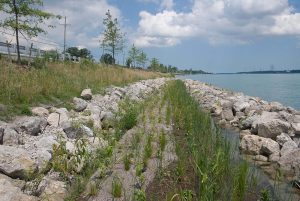Thought Leadership
How Your Projects on the Great Lakes Can Benefit from Living Shorelines
June 10, 2025Great Lakes shorelines are critical areas for plants, animals, and people alike. Most of the population centers and communities in the Great Lakes are built along the shorelines. Plus, numerous species of wildlife depend on the shorelines for habitat, especially those that pass back and forth from the land to the water, such as the northern leopard frog, Blanding’s turtles, and northern water snakes. But our Great Lakes shorelines are also highly fragile due to fluctuating water levels, waves, and ice that can cause erosion and flooding with widespread impacts. How can we protect these critical areas?
Living shorelines is a rapidly growing practice that incorporates natural and nature-based features (NNBF) into shoreline protection and restoration projects. Living shorelines mimic naturally stable shorelines while incorporating engineering practices in a way that integrates ecology and engineering. The design and application of living shorelines requires a combined understanding of water levels, waves, ice, ecology, and human use to create projects that are stable yet ecologically beneficial. In this blog, I’ll discuss the living shorelines design process and how that process can be applied to reduce erosion while creating habitat along the Great Lakes.
Water level fluctuation chart
Water levels in the Great Lakes may fluctuate 3’-6’ over irregular cycles that may vary over 5-20 years. These long-term water level fluctuations drive morphology, sediment transport, and the overall ecology of the Great Lakes shorelines and are key factors in the success or failure of living shoreline restoration. Despite the highly dynamic conditions and fluctuating water levels in the Great Lakes, we can find numerous examples of existing natural shorelines that have adapted to be dynamically stable under these ever-changing conditions.
Existing natural shorelines in the Great Lakes, include but are not limited to:
- Beaches and dunes
- Sand and cobble shorelines
- Coastal wetlands
- Clay bluffs
- Bedrock
![]()
![]()
When designing a living shoreline project, ecologists apply their understanding of naturally occurring physical and ecological conditions of the Great Lakes shorelines to a project, and then consider human factors such as usability, aesthetics, and regulations. NNBF designers begin by understanding the goals of a project—most of the time, living shoreline projects are used to either restore habitat or to protect infrastructure from erosion. Project designs should always be developed around the client’s specific goals, risk tolerance, budget, and resources.
The design process begins by studying the physical conditions of the shoreline. This includes:
- Topography and bathymetry
- High, low, and current water levels
- Wave height
- Ice
- Soils
- Water quality
- The presence of physical structures that may influence waves or sediment transport
Then, restoration designers assess ecological factors, since natural resources should always be part of a living shoreline project. Key ecological factors usually include:
- Native plants that are nearby, or typically occur in similar conditions
- Wildlife-specific goals
- Protected species or sensitive ecological factors that could be impacted by project construction

Rock sill at low water
The physical and ecological factors are then integrated into a project design. Resilient designs will not only tolerate changing site conditions, they will plan for them by building in features to make shorelines naturally resilient. Designers use numerous techniques to develop living shorelines, but all share some common design factors:
- Resistance to waves and ice
- Functionality at both low- and high-water levels
- Native plants and/or natural materials such as wood
- Slopes that allow passage of wildlife across the land-water interface
- Appropriate for local conditions and shoreline types (i.e., beaches/dunes vs coastal wetlands)
- Permittable based on state or federal regulations
Sloped shoreline
Specific living shoreline techniques will vary—however, there are several common techniques that have been successfully applied on projects throughout the Great Lakes, from Minnesota to New York. These include:
- Vegetative techniques—often, shorelines can be protected and restored by simply installing the right native plants
- Grading and sloping—natural Great Lakes shorelines typically have very gentle slopes, often 5 percent or gentler. Re-sloping a shoreline can cause waves to break while allowing vegetation to move with changing water levels
- Rock sills—selectively placed rock can allow for the establishment of plants in high energy conditions while allowing wildlife to pass from the water to the land
- Dune construction and beach nourishment—when sand is lost following high water periods, it is not always available to naturally rebuild beaches and dunes. Adding sand to the shoreline during low water periods by constructing new dunes can provide protection against high water and waves
- Large woody habitat structures—natural wood can break waves and help with sediment accumulation while providing habitat for frogs, turtles, fish, and other wildlife
- Dynamic revetments—dynamic revetments are an emerging technique using shallow sloped cobble that mimics natural cobble shorelines. The cobble moves with waves but is dynamically stable over time.
Large woody habitat structures for shoreline protection
Living shorelines are a great way to restore habitat while reducing erosion, helping maintain our wetlands, beaches, and dunes for plants, animals, and people. GEI has an integrated team of ecologists and engineers that work collaboratively to design living shorelines across all of the Great Lakes. Contact me if you’re interested in learning more!